
Once lines have been hardened into the shapes of letters of the alphabet, their only function is to form words and sentences. They march in straight rows, following the commands of their master, punctuation. But ah, before that stage, when a line is still free and retains all of its original primordial wildness, it can do a thousand things and communicate in a thousand ways. Excerpt from a drawing by Saul Steinberg The designer Milton Glaser emphasized the potential of a simple pencil line: There is no instrument more direct than a pencil and paper for the expression of ideas. Everything else that interferes with that direct relationship with the eyes, the mind, the arm and the hand causes a loss of fidelity.... I like the idea that this ultimate reductive simplicity is the way to elicit the most extraordinary functions of the brain. The domain of the created line began with the first bubbling urschleim , before your words had consonants... Prehistoric cave art from Queensland, Austral...









